An Eternal, Ephemeral Love of Ice
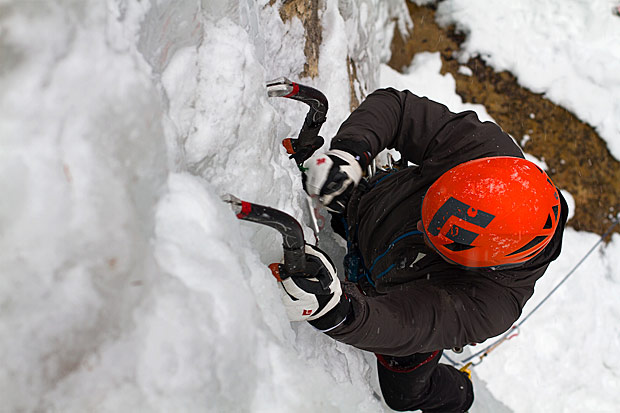
Josh Allison places a screw in Rifle Mountain Park on a recent afternoon. Photo by Cody Smith of whiskeytangolabs.com.
I almost quit ice climbing after a bad year in 2007. That season ended with a near-fatal fall on a routine free solo before dark, in which a tool popped out; I narrowly arrested myself by bridging a chimney with my outstretched body, just before taking the Big Ride. Then, on my first day out the following winter, I was nearly smashed to a stain when a large pillar collapsed above me on a multi-pitch climb (the bulk of the debris shot over the top of me, but the smaller ice bricks beat me up enough that it hurt to breathe for days afterward). I decided then that I must not know what I was doing. It seemed my physical ability was outpacing my judgment.
For one thing, my gear was lacking. Rarely one to blame the inferiority of my equipment for my lack of ability, I reasoned that leading WI5 on flat-tipped snow crampons was perfectly doable. Except the flat frontpoints would skate off of stances at inopportune moments, which made placing ice screws quite terrifying. My old, leashed Cobras didn’t make protection placements any easier, since I had to fumble with the frozen nylon nooses to free a hand that could do the task while warm blood drained from the hand that was tethered above me.
Ice climbing was miserable. For a long time after the two near misses, I only toproped. Even then, there were ice blocks that fell out and clobbered my face as I swung my axes into frozen drips. I ducked most of those, but one block left a temporary scar that turned up at the corner of my mouth. It gave me the effect of a crazy smile that looked like Heath Ledger’s Joker. Was I as crazy as I looked to keep ice climbing? What kept me coming back?

Did ice climbing do this to him? Heath Ledger’s portrayal of the Joker in the movie, The Dark Knight. Batmanwikia.com
I recently interviewed several avid ice climbers – Ryan Jennings, Josh Allison and Mike Schneiter – to see if I might gain some insight on this masochistic pastime.
Cold and Calculating
“I almost think ice is safer [than rock],” said Ryan Jennings, who earned a Golden Piton award with Kevin Cooper for their first ascent of Stairway to Heaven (Alaska 6 A1 M6 WI4 AI5+) on Alaska’s Mt. Johnson last spring. The quote struck me, because my perception of Jennings has been that he’s a little more comfortable with risk than most people. After all, he has survived a 2,000-foot slide after an anchor failed due to thawed ice conditions on the Moose’s Tooth. Our conversation suggested the opposite, however – Jennings might be more accurately described as wary and calculating.
“I have a hard time trusting gear that other people placed, even bolts for sport climbing,” Jennings said. “On ice – especially virgin ice – you can evaluate every tool placement and every screw. And rock can be more committing. You might be runout with crappy pro and you’re getting pumped, but you don’t have any other options but to hold on. With ice, just knowing that I can clip into a tool, or loop the rope over the top of the pick to rest my arms, gives me confidence. There are options. I’ve never actually had to resort to that other than using leashes, but it helps my mind to know that I could.”
He said he tends to avoid free-hanging pillars that are more prone to collapsing. He is also cautious of ice that’s been hacked out, which can be physically easier to climb but has more fractures and wobbly hook placements from so many picks going into the same holes.
“I’m pretty picky about what days I go climbing,” he said.
Jennings said ice climbing is more about mental control and technique.
“Off the couch, I can climb harder on ice than I do on rock,” he said. “I think WI4 is hard. To me, WI4 is dead vertical ice. It almost gets easier above that – the terrain is steeper and more technical, and the pro might be worse, but nine times out of ten, you get rests in between the cruxes; you can wrap a leg around a cauliflowered ice blob, things like that.”
So what is it about ice climbing that he loves?
“I’ve never been much of a cragger,” Jennings said. “I’m usually not one to work a route or repeat a route. With ice, though, it’s different. An ice route is constantly changing. It’s there one day and gone the next, so I come back. Ice lines tend to form direct routes that are inspiring in their appearance.”
Even on small ice routes, you can feel like you’re having an adventure in your backyard, Jennings said. However, he still experiences moments when he wonders if it’s worth it.
“Getting stuck at a bad belay where I’m getting bombed with ice from the leader is one of those times when I wonder why we do it,” he said.
Danger Ranger
Josh Allison, who is a regular competitor at the Ouray Ice Fest, including the speed comp, said the fear that comes with climbing such a shifting element is something he enjoys.
“When you are standing at the bottom, looking up at hundreds of feet of steep, chandeliered ice, there is a combined feeling of nervousness, fear and excitement,” he wrote in an email. “As soon as I’m on a climb, I have to forget everything else that is going on in my life, and climb with 100 percent focus and commitment, knowing that any mistakes will most likely end with an extended stay in a hospital. Ice climbing is a feeling of complete bliss and self-awareness. Once the lead is over, life seems so clear that you can almost see the world in high definition. I guess it is a bit addicting, like a drug of sorts. This is what separates it from rock climbing for me, which can be more physically demanding with little or no danger.”
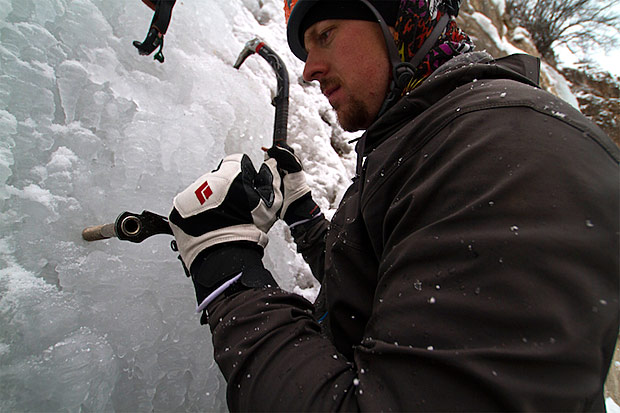
Photo by Cody Smith of whiskeytangolabs.com.
Allison said he’s had days when pillars collapsed hours after he climbed them. There is one close call from last year that stands out, though.
“I was leading a WI5 in Rifle Mountain Park on a day where the ice was a bit more brittle than I anticipated,” he said. “I had placed four screws that, at best, would have slowed my fall before I impacted the ground. I climbed 15 feet above the fourth screw, and as I placed my tool, I dislodged a block that was around 60 or 70 pounds. It hit me square on top of my head. Everything went black instantly, but I still felt fully aware of what was happening around me. I had to use every ounce of my will not to lose consciousness on lead. After about one or two minutes, I was able to regain composure, refocus and finish the lead, but I knew that I used one of my nine lives that day.”
Scary as it was, the experience hasn’t deterred him.
“All in all, the natural high is worth the risk,” Allison said. “Luckily, when God gave me a small brain, he gave me a very hard head!”
Child’s Play
I got to thinking about our motivations for this cold sport last month, when Mike Schneiter of Glenwood Climbing Guides posted a video of his 5-year-old daughter ice climbing for the first time.
“Selah asked to go ice climbing today,” Schneiter wrote on Facebook. “I didn’t expect much, because ice climbing can be such a cold, miserable sport, and I could tell Selah didn’t really understand beforehand what it entailed. We ended up spending most of the day out and I practically had to pry her off the ice after she did ten pitches.”
Selah later added that ice climbing was her new favorite sport, followed by rock climbing and golf. She has since acquired some kid-sized tools and has been out several more times.
“I wasn’t sure Selah would get into it,” Schneiter emphasized. “When we first got there, she thought we were going to be grabbing the ice with our hands. She recently dropped out of a dance class she was in because it wasn’t the kind of dance she had in mind. She had something different in mind and was disappointed that it wasn’t like she envisioned. With ice climbing, I feared the same would happen.”
“Plus, besides weather, ice climbing can be tricky to figure out,” Schneiter said, “and I know this from guiding as well. Rock is pretty straightforward and even natural for most people. You just grab holds and pull. But swinging tools and standing on crampons can be really hard for people.”
Of course in Selah’s case, she doesn’t have to concern herself with any leading or belaying. She just gets to climb. She’s also been climbing as long as she can remember, with her mom and dad watching over her. So there is probably less of a fear factor for her.
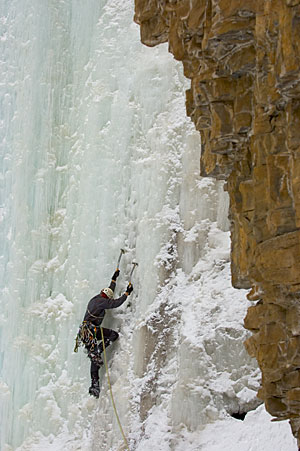
Mike Schneiter climbing Hidden Falls in Glenwood Canyon.
As for Schneiter, he’s been ice climbing 15 years and still doesn’t consider himself a “dedicated” ice climber.
“I don’t go scratching around in the early or late stages of the season,” he said via email. “For me, it’s mostly something to do when it’s too cold to rock climb or the snow isn’t great for skiing. That being said, over the years, I have definitely had some increased personal interest in getting some days on the ice. In general, I just love climbing, period. … I think ice is just another logical way to explore and get into the vertical world. I do enjoy the challenge of going out when it’s really cold and nasty out. I kind of seek that out. … I’ll happily admit to being scared at times early in my ice climbing days, because it can be scary! But, today, I rarely feel scared because I’m more in tune with what’s going on.”
“I hear from a lot of people who quit climbing, or various parts of climbing, because they get to the point where they aren’t willing to assume the risk,” Schneiter continued. “For me, I can’t imagine ever quitting climbing, including ice, because I feel like you can always manage the risk and still have fun. … To be able to climb something so fickle and ephemeral as an ice climb, to me, will always hold a certain allure.”
–
Yes, “ephemeral” – that is the word that matches the feeling for me; the reason why I must keep coming back to the frozen realm of dripping thoughts.
I’m reminded of a New Year’s Eve with one of my best friends. It was my first day with new crampons, and my ability had jumped a grade and a half overnight. My feet no longer skated off stances. It was getting dark. A full moon was rising. There was a pillar in Rifle Mountain Park that had yet to be climbed that season. The bottom was narrow and overhanging. The top was a curtain of chandeliers frosted with snow dust. The lead took 90 minutes and my fingers were wood when I reached the top. For a short eternity, I howled in pain from my high perch as blood made its way back into frozen capillaries.
But the way the moon shimmered on the ice!
How perfect it was!
How magical to be there, alone with a close friend, enveloped by the canyon and stars; pulled from our Earthly bubble by the giant, orbiting moon. Like a drop.
How … ephemeral.
Derek Franz writes a blog for SplitterChoss.com once a month. To find more of his writing, visit www.derekfranz.com.
4 Responses to An Eternal, Ephemeral Love of Ice
Bulldog Creek Dog Walk (IV WI 4+)
Hayden Carpenter and Tom Bohanon recently repeated an obscure ice climb on the south side of Mt Sopris. Given a brief mention in Jack Robert’s ice guide, Bulldog Creek Walk is described as being 100 meters of WI 4. What they found was seven pitches of ice in a remote setting that makes for one […]
Connect with Us








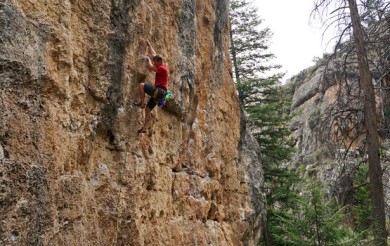
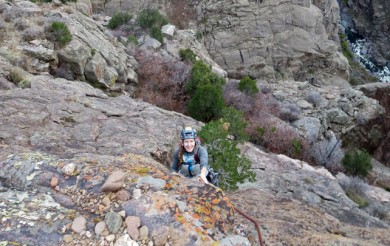
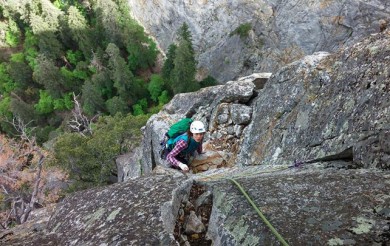
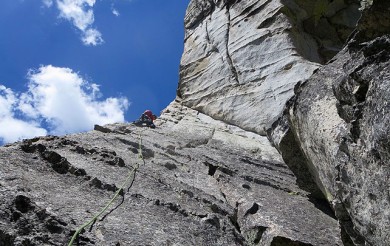



Great post! Captures the many sides of the sport, Ephemeral indeed!
Thank you, Brendan!
Many a key insight into the mind of the leader on hard ice routes. But what of the poor sucker left holding the rope for 90 minutes in the cold and snow? An equally important time for self evaluation…. Also, nice work!
Thanks for holding the rope that day, Todd. That wasn’t the only time you were there for me, either, which is why I asked you to be my best man at the wedding. Thanks, buddy!